I have written in past Pacific War columns about institutional or personally motivated false narratives, narrative hagiography, forgotten via classification narratives and forgotten via extinct organization narratives. Today’s column, like my previous “History Friday: 81st ID’s Peleliu Lessons for MacArthur’s Invasion of Japan” is another on how generational change makes it almost impossible to understand what the WW2 generation is telling us about it’s times without a lot of research. The case in point in this column is the confused development of the mechanized flamethrower tank.
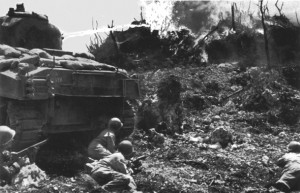
To take you there this time, first imagine a weapon who’s range and effectiveness varied from shot to shot. Who’s performance was dependent on the wind. Whether it was raining or it got soaked in salt water. Whether a rubber O-seal held pressure or the connection in which it was placed was properly seated. A weapon who had a two component ammunition, solid and liquid, you had to mix in the field before use. That required the chemicals in the solid component of ammunition to be properly ground to a consistent powder with no trace manufacturing contamination, and that required air and water tight packaging of your ammunition hold up in shipment. Which also required of the liquid batch of ammunition you were using not to have had too much water or alcohol contaminating it. And whose mixed performance rapidly and unpredictably deteriorated within hours to weeks since the manufacture of that batch of ammunition, when you did everything right.
It gets better.
This weapon has an effective range of 10 to 20 yards depending on all of the above, requiring a team of 7-15 other soldiers to cover you, as you move up to use it. Your last live fire training — in fact, any training at all — in using this 70 lb back pack weapon with your team happened more than 30 days before you use it. Which, by the way, has an effective firing time in combat of 8-to-10 seconds, and you as its operator are the enemy’s priority target on the battlefield.
Your mission, your life, and the lives of around you, are depending on this weapon. And worse, for all those problems, it was the only effective weapon you have…when it works.
Those were the facts of life and death for every American portable flame thrower operator in World War 2. It took 18 months of bloody infantry close combat from December 1943 to June 1944, with four increasingly better and more dependable portable flamethrower designs, to work out all those facts.
And it was not until November 1943, with the shatteringly high U.S. Marine casualties during the assault of Betio Island, Tarawa Atoll, Gilbert Islands, that the American military began to seriously entertain fielding a flame throwing tank.
HISTORICAL BACKGROUND
The pre-Tarawa history of American flame tank development was dominated by disinterest and failure. The Chemical Warfare Service was utterly disinterested with flame throwers before World War 2 (WW2) and had scrapped all of its left over models of its World War 1 (WW1) portable flame throwers. The German success with portable flame throwers with Belgian forts and British Petroleum Warfare Department efforts with mechanized flame throwers heavily influenced it into making several mechanized flame tank prototype developments.
Figures 2 & 3 below are examples of that effort. They were the gas pressurized mechanized flame thrower in a M2A1 Medium tank.

And the pump pressurized E3 mechanized flame thrower in the M3 Grant Tank.
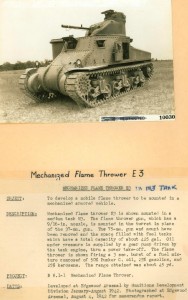
Neither the E2 nor the E3 could be considered a combat capable vehicle. In the case of the E3, it suffered from design flaws in it’s pneumatic pump pressurized flame system that made the effective used of gasoline thickened with Napalm impossible. This halved the 150-to-200 yard (137-to-183 meters) range achieved later with properly design gas pressurized and pump pressurized flame tanks.
The death of General Chaffee by cancer in August 1941 and the long range tank combat in the North African Deserts of 1940 through 1943 killed any US Army Armored Force interest in flame tanks. Chaffee’s early patronage of flame tanks was part of his agreement with the Infantry branch to provide an infantry support tank for assaulting fortifications. The dissolution of the Infantry Branch by General Marshall before Pearl Harbor. Chaffee’s replacement as the head of the Armored Force. Plus the establishment of the Army Ground Forces (AGF) under General McNair with the concurrent demotion of the “Armored Force” — a branch in all but name — to an”Armored Command” and establishment of the McNair “user need before weapon development” standard prevented any flame tank development prior to Tarawa.
The US Army’s Chemical Warfare Service knew that this assessment was wrong, but being buried inside the Army Service Force it did not have the budget, the priority nor a valid “user requirement” requirement to pursue mechanized flame thrower development. So it took advantage of the recently established National Defense Research Committee (NDRC) and punted all vehicular flame thrower development and basic research for pumping and pressurizing Napalm in them to the NDRC’s Division 11. From 1941 through early 1943 the NDRC “held the torch” with vehicular flame thrower development using Standard Oil Development (SOD) as its primary industrial development partner. This development effort confirmed that air pressurizing napalm was a viable means of propulsion and fore saw the creation of specialized service units to provide both pressurized air and properly mixed “vehicle grade” 7% to 10% by weigh napalm-gasoline flame-fuel.
Meanwhile the CWS rapidly developed several portable flame throwers before settling on the M2-2 flame thrower design that had a water proof chemical match ignition source similar to captured Japanese flame throwers rather than one using an electrical spark and secondary hydrogen fuel to ignite napalm streams. The portable flamethrower was heavily used in South Pacific fighting with the Japanese, but was seldom if ever used in North Africa, Sicily and Italy. This set the stage for what followed when the Tarawa requirement for an mechanized flamethrower emerged in the Pacific.
First, the Armored Force absolutely balked at the thought of a medium tank with a main armament flamethrower. The US Army was producing tens of thousands of M4 Sherman tanks but the needs of lend lease to arm allies and the need to fill supply chains thousands of miles long taking 150 days from request to arrival to deliver tanks to troops made every M4 precious. Even MacArthur’s SWPA did not think it could spare even a single M4 Sherman for flamethrower main armament medium tank. The compromise worked out was that the CWS would develop and auxiliary flame throwers for medium tanks and a joint CWS/NDRC effort would develop a workable flamethrower for the M3/M5 Stuart light tank. The US Navy also lent a LVT(A)1 Amphibious tank as a flame tank development.
The auxiliary flame guns followed three paths. The first was the “M3-4-3” (this reads flame tank unit M3, flame tank unit M4 and flame gun M3) flame system using the hull machine gun position on the Sherman and Stuart tanks and pair of 25 gallon and a single 10 gallon napalm tank unit (which was never used in combat) respectively. The second was the “E6” periscope flame gun used on the hull machine gunner’s hatch. It went through four separate versions (E6, E6R1, E6R2and E6R3) until finally produced in small numbers and missing the war. The final development path was the E6 auxiliary machine gun coaxial flame thrower, later changed to “E15” to avoid confusion. This was a low priority dead end that saw a rapid development in the final three months of the war and was tested as the E22 coaxial flame gun post war prior to cancellation in 1949.
The M5A1 designs also followed three design paths. The air tank pressurized E7-7 with a turreted “Q” for “Quickie” SOD flame gun. The E8-8 which replaced the turret with an assault gun like super structure and a new NDRC E-8 flame gun. And the E9-9 with a Churchill Crocodile like pump pressurized trailer unit and dual light and heavy flame guns. Figure four below shows the E9-9 unit.
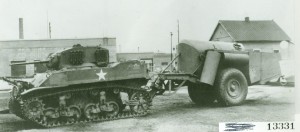
Colonel Unmacht — ARRIVING!
The Spring and Summer of 1944 saw several developments that diverted all but four dozen auxiliary flame guns to Europe, Delayed the LVT(A)1 amphibious flame tank and canceled all three Stuart flame tanks. These developments started the ball rolling for a number of M4 Medium flame tank designs. The most important development for the CWS was a disastrous accident that destroyed the E9-9 flame tank that was eventually traced to poor welding in its pump pressurized 800 gallon trailer. This killed further development of the E9-9.
The second development was the US Navy Ordnance board disapproving the CWS modification of LVT(A)1 over seaworthiness concerns, delaying the design past the end of WW2.
The third development was the absolute priority granted to the European theater of operations (ETO) over all M3-4-3 production over the Pacific Theater after the first four dozen were delivered to the South Pacific. This starved the Pacific theater of flame tanks while Armored Force generals like Patton stored unwanted infantry support M3-4-4 auxiliary flamethrowers in warehouses.
That misguided ETO priority lead to the development in Hawaii by the chief chemical officer in the Central Pacific/Pacific Ocean Area theater of the “Satan” flame tank using the Canadian Ronson vehicular flame thrower. Colonel Unmacht of the CWS was weight for weight the most effective rear area service command officer in World War 2. He managed to simultaneously make and keep as patrons General Richardson of the Central Pacific, General H. M. (“Howling Mad”) Smith of the US Marine Corps in pursuit of flame tanks for Marine and US Army ground forces in the Pacific. Anyone familiar with the “Smith versus Smith” controversy where General “Howling Mad” Smith of the USMC relieved the commanding General Smith of the 27th National Guard Infantry Division in the Marianas campaign will be in awe of Col. Unmacht’s deal making and diplomatic skills with American Pacific Theater high command.
Unmacht’s example forced the AGF to turn over first three and then later 20 more M4 Shermans for developing the E12-7R1, E13-13 and E13-13R1 flame tank prototypes and a “limited combat testing” quantity of 20 of the E12-7R1.
In the meantime,the summer of 1944, Unmacht further convinced General Richardson to turn over a further 54 M4 Sherman tanks being replaced by Ford engine powered M4A3’s for conversion for a future Tenth Army operation against Formosa (canceled and replaced by Okinawa) and “did a deal” to keep See Bee’s involved in his Hawaiian Flame Tank group when their battalion deployed to Saipan in exchange for eight M4A3 flame tanks for Iwo Jima.
In January 1945 the production numbers of the E12-7R1 were increased to 300 vehicles…but its industrial priority was not. This meant only rebuilt cast hull M4A1 used for training in 1943-44 were available for the program and not many of them.
In March 1945 the Chief Warrant officer of one of the USMC tank battalions AT Iwo Jima was flown to Ft. Hood to report on his combat experience with Unmacht’s flame tanks to the E12-7R1 development team. As Unmacht’s Hawaii Flame Tank Group was developing its 2nd Generation coaxial main armament flame tanks, the number of E12-7R1 to be produced was raised to 640…without a higher production priority.
Under Secretary of War Patterson Intervenes
That same month, March 1945, there was a visit from the Pentagon by General Wilhelm Stryer and special assistant to Under Secretary of War Mr. Howard Peterson to Unmacht’s Hawaii Flame Tank Group. One of the highest priority subjects for Col Unmacht to discuss with them was the non-availability of tanks for flame tank conversion efforts. See Figure 5 below.
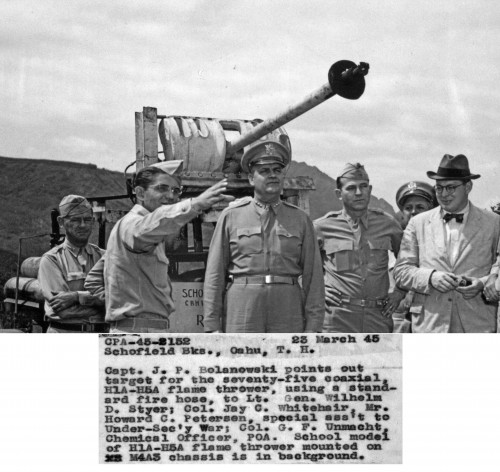
In May 1945 German surrendered and the War Department started a phased demobilization by among other things cancelling the further production of M4 Sherman tanks as of 30 June 1945. This development left the CWS flame tank programs without anything to mount its mechanized flame throwers on!
Concerned over the availability of flame tanks, MacArthur cabled the War Department in late June 1945 about the E12-7R1 stating it should have the highest priority for Operation Olympic. This caused an action on the part of Brig. Gen. William A. Borden, Director of the New Developments Division, War Department Special Staff, who asked the Assistant G-4 of the Army to place a Triple “A” priority on it to assure its production. The assistant G-4 never got the chance.
On 27 June 1945 Under Secretary of War (and future Secretary of War for Sept 1945 July 1947) Robert Patterson intervened in this US Army bureaucratic priority dispute — likely on the advice of his special assistant Mr. Howard Peterson — to expedite production of flame tanks for the invasion of Japan. This action resulted in all flame tank programs being given the same “Triple A” procurement priority held by the B-29 and the Atomic bomb. By the time of the Nagasaki A-Bombing, this “Triple A” priority had been applied by the US Army’s Chemical Warfare Service across all of its flame tank programs to “get nine women pregnant to have a baby in a month” and deliver more Flame tanks for the invasion of Japan.
This resulted in a huge number of flame tank programs and well over 1,500 flame tanks of various sorts planned for production in late 1945. Less than 300 of various flame tanks were built and some of them were so forgotten they never made it from the CWS files to the US Army Green Book histories.
Below is the list I have gathered to date of those programs:
Chemical Warfare Service Mechanized Flamethrower Cancellations
1) E12-7R1 Mechanized Main Armament Flame Thrower in M4A1 or M4A3 tanks (4.4 Gal a sec delivery with 290 gallons fuel)
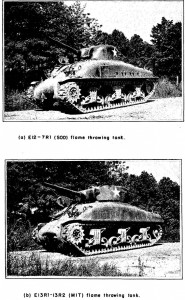
151 produced in M4A1 tanks produced by 31 Oct 1945 out of 640 on contract, balance canceled. Production of last 67 to be in Jan 1946.
2. Morgan RAM E13-13. (4.4 Gal a sec delivery with 290 gallons fuel)
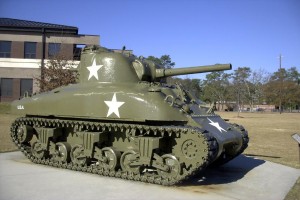
On or about August 9th 1945, a letter contract was issued by Major Hollingsworth of the Chemical Warfare Service (a veteran of the Hawaii Flame Tank Conversion effort) for the production of additional Morgan RAM E13-13 flame tanks.
Morgan, the contractor, replied that given the M4 Sherman tanks, it could produce to the following schedule to support the invasion of Japan:
10 units at end of the 9th week (15 Oct 1945 10 total)
10 units at end of the 10th week (22 Oct 1945 20 total)
15 units at end of the 11th week (29 Oct 1945 35 total)
20 units at end of the 12th week (05 Nov 1945 55 total)
25 units at end of the 13th week (12 Nov 1945 80 total)
25 units each week there after until completed. (19 Nov 1945 thru — 11 Mar 1946)
80 + 425 = 505 E13-13 Morgan flame tanks.
It was intended that this tank be equipped with a combined mechanical pump pressurization and Napalm mixer system. This system was pursued after WW2 with the “E21-7R1” in a M4A3 Sherman tank. All of these 505 flame were canceled at war’s end.
3) E14-7R2 main armament flame thrower in LVT(A)-1 Amphibious Tanks (4.4 Gal a sec delivery with 200 gallons fuel)
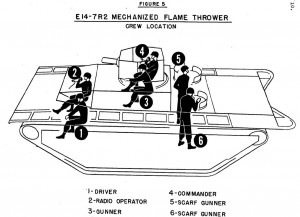
10 produced by 21 Oct 1945 out of 50 on contact. Balance was canceled.
4) T33 Mechanized Coaxial Main Armament Flame Thrower in M4A3E2 Jumbo Sherman hull, with new cast turret containing the E-20-20 flame gun coaxial to a M6 75mm cannon (from M24 Chaffee Tank.) (4.4 Gal a sec delivery with 265 gallons fuel)
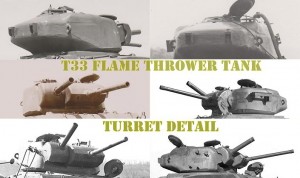
All 300 new construction canceled V-J Day. Development program for 3 prototypes on existing hulls post war. Production slated to start Jan 1946 to replace E12-7R1 in engaged forces Operation Olympic and for Operation Coronet forces staged from USA.
5) E19-19 Mechanized Coaxial Main Armament Flame Thrower in M4A3 (76) (estimated 4.4 Gal a sec delivery with 130 gallons fuel)
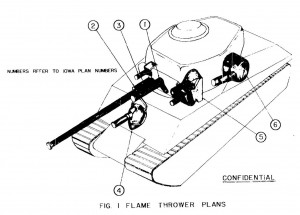
One prototype and 19 limited production models canceled on V-J Day. This would have left 1/2 normal 76mm ammo in load tank. It would be converted by 4th echelon maintenance centers in the field. It was planned that these would displace M3-4-M3 and M3-4-E6R3 Auxiliary Armament mechanized flame throwers. IMO, extended production of this (beyond the 20 projected) unit would have been the primary flame tank for the Armored Divisions (13th & 20th) for Operation Coronet. Most likely, again IMO, a “E19R1-19” unit in the M4A3(105) in the tank and armored infantry battalions and medium tank companies would have M26 and light tank companies the M24 Chaffee.
6) M3-M4-E6R3 Mechanized Flame thrower, Periscope. Auxiliary Armament for M4A1 and M4A3 Tanks.
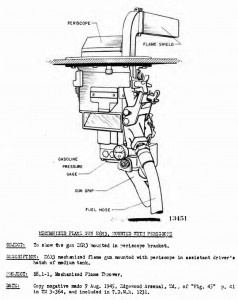
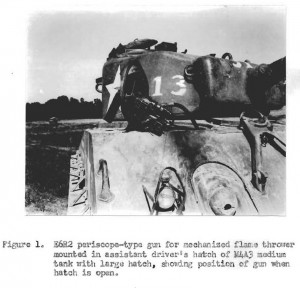
Only 192 of 500 were built by V-J Day. Balance was canceled.
Late War (June-Aug 1945) and post-war testing showed the E6R3 flame gun was high performing in terms of ignition, range and traverse compared to other aux-flame guns, but it was temperamental, delicate and above all high maintenance. It was standardized as the M6 gun in the M3-4-6 in Dec 1947 by the the US Army Chemical Corps and the remaining 144 M3-4-6 units were discarded as obsolete in 1949 by US Army Field Forces action.
7) T35 Mechanized Coaxial Main Armament Flame Thrower in M26 Pershing.
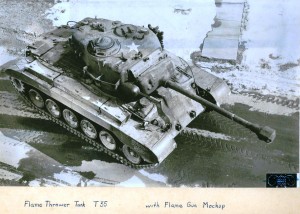
While the M26 was considered for several flamethrower designs during the war. The particular type pictured was a development program started in Oct 1945. It was unlikely a full up Co-axial main armament flame tank M26 would have been available before April 1946 if the war had continued. It was intended that M26 tank have a pump operated napalm storage system with a Napalm mixer/compressor built in. The most likely extended Pacific War design outcome was that late production E12-7R1 (Standardized as M5-4) would have been completed as the post war E21-7R1. And the E21 fuel storage system with Napalm mixer/compressor would have been placed in the T33 in M4A3E2 as a nominal “E21-20” system. The 50 HP power take off unit to power the pump available for the E21 fuel system could only support a 5/8th inch nozzle as opposed to a 3/4 inch nozzle. This would reduce the flow rate from 4.4 gal a second to something on the order of 3.3 gal a second. The post war T35 has a 200 HP PTO for a 3/4 inch nozzle.
8) E1 Scorpion/Skink self-defense flame thrower
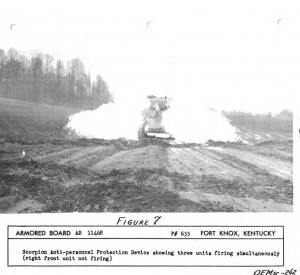
There were 20 units authorized with 2-gal capacity and 15-20 shots. Four per tank as a complete set. Some built (?), the rest canceled. The unit was in early 1960 Chemical Corps R&D manuals as possible tank armament into the early 1960’s.
9) E8/E8R1/M4 Service unit on 2&1/2 ton truck (air compressor & napalm mixer) for E12-7R1

Pilot production of 10 units and limited production of 150 units authorized. There were 64 of all types built and only 59 were accepted to service as M4 post war. Some additional number for the T33 would have been built at a rate of one per four T33.
10) E6 Mixer and E8 Compressor sets for E14-7R2
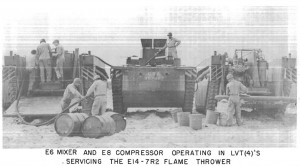
A pilot production of six E6 Mixers and six E8 Compressors were completed prior to the Japanese surrender. One set for every four E14-7R2 was projected, AKA 13-14 sets, with some number for the T33 based on combat feed back.
11) Canceled — 200 E-18 Mechanized Assault guns for E12-7R1 Flame Tanks.
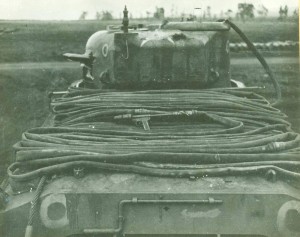
These were new prototype flame guns adapted from the M2-2 portable flame thrower with 400 feet of 1 & 1/2 inch Napalm proof hoses. They were to replace the Hawaii flame group fire hose and M-2 flame gun system used on Okinawa due to the fire hose’s structural weakness. (Figure Above) All were canceled after V-J Day.
Summary
The rapid end to WW2 resulted in the equally rapid forgetting of all that the “Greatest Generation” had learned about Napalm spitting flame tanks. It took the Korean War with left over Unmacht made flame tanks in USMC hands to reawaken the mechanized flamethower tank production base in the middle 1950’s on the M48 Patton tank. That was a huge irony given Armored Force Generals like Patton’s dislike of flame tanks. Patton would rather have forgotten about them entirely, which generations of soldiers in the US Army after Patton did.
Sources and Notes:
(Updated 7 Nov 2013)
A.W. Adkins, G.A. Agoston, A. Bogrow, K.J. Mysels, “Joint CWS-NDRC Mechanized Flame Thrower Evaluation Project” Division 11 of the National Defense Research Committee of the Office of Scientific Research and Development, Report OSRD No. 5933, Copy No. 31, June 30, 1945
Leo P. Brophy, Wyndham D. Miles and Rexmond C. Cochrane, UNITED STATES ARMY IN WORLD WAR II, The Technical Services, “THE CHEMICAL WARFARE SERVICE: FROM LABORATORY TO FIELD,” OFFICE OF THE CHIEF OF MILITARY HISTORY, UNITED STATES ARMY, WASHINGTON, D.C., 1959, Page 370
John N Bruce, Charles T Mitchell, “Development of Mechanized Periscope-Mounted Flame-Thrower Gun E6R3,” CHEMICAL CORPS TECHNICAL COMMAND ARMY CHEMICAL CENTER MD, 2 Mar 1946, DTIC Accession Number: ADB970252
“DEVELOPMENT OF FLAME THROWERS, SERVICE UNITS, AND THICKENED FUELS BY STANDARD OIL COMPANY,” National Defense Research Committee Division 11 of the Office of Scientific Research and Development, OSRD REPORT No. 6376, COPY 21, October 31, 1945
Leo Finkelstein, HISTORY OF RESEARCH AND DEVELOMENT OF THE CHEMICAL WARFARE SERVICE IN WORLD WAR II (1 JULY 1940 – 31 DECEMBER 1945) Volume 15, Part II, FLAME THROWERS, TECHNICAL COMMAND, ARMY CHEMICAL CENTER, MARYLAND, 1 MAY 1949
L.A. Maltby, Theory Loew, John N Bruce, Charles T Mitchell, “Development of Mechanized Flame Thrower, Model E4R2-4R3-5R1,” CHEMICAL CORPS TECHNICAL COMMAND ARMY CHEMICAL CENTER MD, 28-May-1945, DTIC Accession Number: ADB968761
LT COL LEONARD L. McKINNEY, CML C-RES., CHEMICAL CORPS HISTORICAL STUDIES No. 4 “PORTABLE FLAME THROWER OPERATIONS IN WORLD WAR II” Historical Office Office of the Chief, Chemical Corps, 1 December 1949 Pages 1 – 25
LT COL LEONARD L. McKINNEY, CML C-RES., CHEMICAL CORPS HISTORICAL STUDIES No. 5 “MECHANIZED FLAME THROWER OPERATIONS IN WORLD WAR II” Historical Office Office of the Chief, Chemical Corps, 14 February 1951
Monthly Progress Report to Division 11 of the National Defense Research Committee on MORGAN RAM TYPE FLAME THROWER FOR M4A1 TANK covering period July 15 August 15, 1945, File No. 11-498, Contract OEMar-1364, Directive CWS-10, Army L.O. Brig. Gen. W.C. Kabrich, Navy L.O. Major J.W. Mehring (USMC), page 2
“Report of Activities of the Technical Division During World War II”, Army Service Forces, Office of the chief, Chemical Warfare Service, Washington, D.C., 1 January 1947 — CHAPTER XVII – FLAME THROWERS pages 139 – 148 Passim
“Report of Conference on Mechanized Flame Thrower E12-7R1” Armored Board – 23 March 1945
SUMMARY TECHNICAL REPORT OF DIVISION 11, NDRC, VOLUME 3, “FIRE WARFARE INCENDIARIES AND FLAME THROWERS”; OFFICE OF SCIENTIFIC RESEARCH AND DEVELOPMIENT, VANNEVAR BUSH, DIRECTOR; NATIONAL DEFENSE RESEARCH COMMITTEE JAMES B. CONANT, CHAIRMAN; DIVISION 11 H. M. CHADWELL L. CHIEF; WVASHINGTON, D. C., 1946
T.D.M.R. No. 1252, Project B 8a, Hose Extension for Flame Throwers, established in the 1944 project program, Letter CHS 470.71/163 (c) GNRQT 6/28460 HQ, AGF, 31 May 1945.
Subject: Flame Thrower Hose Extension to CG, ASF and 1st endorsement thereto, dated 6 June 1945, authorized the C.W.S. to initiate the development and procurement of 200 extension flame throwers.
Lincoln R. Thiesmeyer and John E. Burchard. Volume editor, Alan T. Waterman; foreword by Karl T. Compton. “Combat Scientists,” SCIENCE IN WORLD WAR II, Office of Scientific Rescarch and Development, Little, Brown and Company, Boston, 1947 234 – 239
Col George Unmacht, ‘Flamethrower Tanks in the Pacific Ocean Areas’ Military Review, March 1946 pages 44 – 50
They had a major problem with Tarawa because they did not plan the landing properly. The landing craft wound up on a reef that was far offshore. Just poor planning.
What about mechanized flame weapons in Europe?
Another fantastic article, thank you very much. Your Friday posts are required reading.
The M3-4-3 was placed in Europe in numbers on the order of the low 100’s.
Only a couple of dozen were used and none in the 3rd Army or Italy.
The 1st and 9th Army were the primary users of the M3-4-3 and M4A3E2 Jumbo Sherman’s were the primary carriers, although deployment was not limited to them.
The US Army also got four Sherman Crocodiles that were used in one independent tank battalion.
Were they used in Korea or Vietnam?
A small number were used a half dozen times in Korea.
I will post a link when I have time.
See this:
DS60 Item nos. 65-82 – Eighth (8th) United States Army Korea (EUSAK),
A Study of action, the mechanical flame thrower in action at Yongdae,
Korea, August-November 1951
http://www.benning.army.mil/library/content/Virtual/Documents/Microfilm/film/DS60_I65-82.pdf
The PDF runs to 228 meg.
The sources and notes section has been updates as well as the E13-13 vice E13-13R1 flame tank designations.